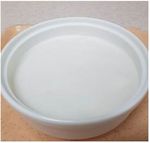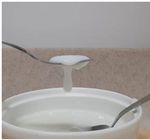IDDSI SPECIAL FEATURE - August 2021 Rice porridge around the world with IDDSI
←
→
Page content transcription
If your browser does not render page correctly, please read the page content below
IDDSI SPECIAL FEATURE – August 2021
Rice porridge around the world with IDDSI
Introduction
Rice is a staple food in Asian countries. Rice porridge, also known as congee, is a
variety of such stable food that is very common in Asia. There are many ways to cook it and
they may look different in different cuisines. You can find congee in different Asian cuisines,
such as Chinese, Malaysian, Taiwanese, Singaporean, Japanese, Korean, Vietnamese and
Indian food. The common ingredients to different types of congee is rice and water. A number
of qualities of the congee varies across regions, for example, the water to rice ratio, the
softness of the rice, the consistency of the congee and the types of meat, vegetables or
seasonings that are added to the congee.
Congee is considered as a comfort food, healthy food and a recommended dish for
those who are sick. It is likely because it is believed to be easy to chew, digest and swallow.
It warms up the body as it is served hot. However, congee may pose a special threat to those
who have swallowing difficulties because of its mixed consistencies. In this article, we will
introduce some common types of congee to the readers and highlight the features of each
type. Case studies are included to show how congee may affect swallow safety. We will also
discuss what precaution we should take when serving this common dish to those who have
swallowing difficulties.
Common types of plain congee in Asia
Taiwan
Congee is a versatile dish in Taiwan, it can be prepared either from raw rice or from
cooked rice, with rice cookers or pots made of different materials. Congee may be served plain
or cooked with other vegetables, legumes, meat, eggs and spices.
Here we are describing plain congee that was bought from a food stall in Taipei,
Taiwan. The congee has been tested with spoon tilt, fork test and finger test at three different
temperatures: at 60, 50 and 40 degrees Celsius. The results are depicted below. In all three
temperatures, there was little residue left on the spoon in the spoon tilt test, minimal liquid
dripping and no solid dripping through the prongs of the fork in the fork test, and the grains
1were easily smashed with fingers in the finger test (the grains were really slippery!). Although
the results were similar in all 3 temperatures, the porridge seemed to be visually thicker as the
temperature dropped.
Spoon tilt Fork test
Testing at 60oC
Finger test
Spoon tilt Fork test
Testing at 50oC
Finger test
Spoon tilt Fork test
Testing at 40oC
Finger test
2Hong Kong -- The Cantonese-style and the Chiu Chow-style congee
Cantonese-style congee:
The Cantonese-style congee starts with soaking the rice in water for at least one
hour. The rice will then be cooked and simmered in a large amount of water for a prolonged
period, or until the rice grains have bursted open and the congee is “creamy” and smooth.
The rice appears to have “melted” into the liquid and the two are not separable. The
Cantonese-style congee usually meets IDDSI Level 5 (Minced & Moist). Note that the
Cantonese-style congee is often ‘sticky’ as can be seen from the amount of congee sticking
onto the spoon in the spoon tilt test. Video 1 shows the fork drip test of the Cantonese style
congee. See Video 1 here.
Spoon tilt test Fork drip test Fork pressure test
Chiu Chow-style congee:
Another popular type of congee in Hong Kong is the Chiu Chow-style congee. As
compared to the Cantonese-style type, the Chiu Chow-style congee requires considerably
less time to cook. In the end product, the rice grains still appear “intact” and may be separated
from the liquid. The Chiu Chow-style congee is considered as mixed consistency, with the rice
part at IDDSI Level 7 (Regular) and the watery part at IDDSI Level 0 (Thin). If this type of
congee is to be consumed by people with swallowing difficulties, it is suggested that the rice
grains should be drained from the liquid. The solid and liquid contents should be prepared to
the IDDSI levels recommended by the patient’s speech therapist. Video 2 shows the Chiu
Chow-style congee and the related spoon and fork tests. See Video 2 here.
3Singapore -- An example of specially prepared congee at the hospital setting
Following an assessment by a Speech Therapist, patients with swallowing difficulties
may be recommended to take a fully pureed diet. For these patients, chewing is extremely
difficult and inefficient. Their tongue strength may be weak, which results in poor ability to
move food around the mouth to chew and swallow. They may also have missing teeth or
poorly fitted dentures.
To prepare pureed congee, regular congee is blended up to a smooth and lump-free
consistency. Additional soup stock or water can be added to facilitate the blending process if
it is too cohesive and sticks to the blender blades. However, this should be added in small
increments to avoid making the final product too watery.
Pureed congee can be prepared to meet either IDDSI Level 3 (Liquidised) or IDDSI
Level 4 (Pureed). It is often easier to achieve IDDSI Level 3 (Liquidised) for the final congee
product due to the nature of this carbohydrate. It may also be more natural and palatable to
consume pureed congee at a IDDSI Level 3 (Liquidised) consistency. To achieve a thicker
consistency at IDDSI Level 4 (Pureed), additional soft rice, potato starch, or thickener powder
may need to be added during the preparation process. A thin film often forms on the top layer
of the congee after leaving it to sit. This film should be removed or mixed in again before
feeding.
Pureed congee IDDSI Level 3 IDDSI Level 4
smooth and lump free (Liquidised) (Pureed)
Please check in with your Speech Therapist on whether IDDSI Level 3 (Liquidised) or IDDSI
Level 4 (Pureed) is more suitable for your loved one to consume.
4Case study 1: Aspiration risk with rice with excess gravy, as compared to thick porridge at
Level 5 Minced and Moist
Here we illustrate the case of a 73-year-old lady who had a recent pontine stroke on a
background of previous multiple strokes and deconditioning. She was at this point still on
nasogastric feeding and was looking to increase the repertoire of diet textures that she could
safely take. Apart from weakness in her oral muscles such as jaw and tongue, she was also
edentulous. Videofluoroscopic Study of Swallowing (VFSS) revealed that she had reduced
ability to masticate and manipulate food but was able to take softer textures. She had poor
control of fluids, delayed swallow triggers, incomplete airway closure and reduced base of
tongue strength.
This lady’s family were keen to explore the ability to take rice with some water or gravy,
instead of just having plain porridge, so that they could add more variety to her meals. The
following VFSS images and videos show increased risk of aspiration for rice with small
amounts of gravy. Even though the gravy was thickened to Level 1 Slightly thick, it flowed
posteriorly at a different pace while the patient was still masticating on the rice itself. The gravy
entered the airway and was later aspirated with more trials. In comparison, aspiration risk for
thick porridge without excess fluids was significantly reduced as the bolus travelled more
cohesively throughout the swallowing process.
5The excess gravy at Level 1 Slightly thick was transferred posteriorly at a different speed
from rice, and poses an additional penetration / aspiration risk. See Video 3 here.
Porridge that did not have excess fluids posed less risk as the bolus travels cohesively. See
Video 4 here.
Malaysia
The commonly found congee in Malaysia mostly looks watery
and granulated. Whether it is home cooked or from restaurants, the
Malaysian congee mostly ranges from IDDSI Level 3 (Liquidised) to
IDDSI Level 5 (Minced & Moist). This type of congee can be easily
prepared by cooking rice mixed with water (ratio 1:10) using a pot
and on a low heat for at least 30 minutes (see video 1).
See Video 5 here.
The followings are two case studies that highlight how
different types of congee may affect swallow safety.
Case Study 2: Thick and granulated congee -- IDDSI Level 5 (Minced & Moist)
The pictures below were taken from the recording of a flexible endoscopic examination
of swallowing (FEES) on a 65 years old gentleman while he was eating congee. The patient
6was diagnosed with left basal ganglia bleed with right hemiparesis. He has lost most of his
molar teeth; poor orolingual control resulted in inadequate bolus formations. During FEES, the
patient demonstrated delayed initiation of swallow (1a); penetration and aspiration on
granulated rice (figures 1b and 1c); post-swallow residue was found mostly on valleculae,
some on the laryngeal vestibule and pyriform sinus (figure 1d).
1a. 1b.
1c. 1d.
Case Study 3: Congee -- IDDSI Level 3 (Liquidised) to Level 5 (Minced & Moist)
The next case study is an 81-year-old gentleman with underlying hypertension and
cerebral infarct 2 years ago prior to the recent admission of dengue encephalitis plus
pulmonary tuberculosis (PTB) treatments. He was reported to be tolerating a regular diet very
well prior to admission. He was on nasogastric tube feeding since admission but the caregiver
had started to feed him orally with congee and was reported to only cough occasionally during
mealtimes. However, he was reported to have persistent coughing when drinking water.
Clinically, he had lost the majority of his teeth with a few incisors left with absence of
dentures. Cognitively, the patient had difficulty retaining new information and he was
dependent when carrying out activities of daily living. FEES revealed that he had severely
delayed pharyngeal swallows, aspiration on liquids and congee that was at IDDSI Levels 3 to
5. The patient did not aspiratate but only showed penetration when the congee was at IDDSI
7Level 4 (Pureed). However, he had valleculae residue and was unable to clear with
compensatory strategies. He also aspirated on liquids that were given in an attempt to clear
the residue. Video 6 shows the FEES examination of case study 3 that shows penetration and
aspiration. See Video 6 here.
Why does this matter?
Most patients with swallowing problems will have difficulty tolerating congee with varied
consistencies. Patients with poor tongue control and poor coordination of swallow movements
are at risk of aspirating on the liquidised part of the mixed consistency congee. Patients with
difficulty in chewing and inadequate bolus preparation are at risk of penetration or aspiration
on the granulated part of the congee. Instrumental swallowing assessments may be necessary
to confirm the patient’s tolerance to different types of congee, especially in terms of silent
aspiration and residue. Education is important to ensure patients and carers are aware of how
congee may increase the patient’s risk of aspiration and aspiration pneumonia.
Acknowledgement:
This article was jointly prepared by the following reference group members:
Karen Chan, Hong Kong IDDSI Reference Group, Speech Therapist
Elaine Kwong, Hong Kong IDDSI Reference Group, Speech Therapist
Esther Tuin, Malaysia IDDSI Reference Group, Speech Therapist
Faith Ng, Malaysia IDDSI Reference Group, Speech Therapist
Wai Yun Xin, Malaysia IDDSI Reference Group, Speech Therapist
Yan Shan Lee, Singapore IDDSI Reference Group, Speech Therapist
Chriselle Koh, Singapore IDDSI Reference Group, Speech Therapist
Cristiane Hsu, Taiwan IDDSI Reference Group, Speech Therapist
8You can also read



























































